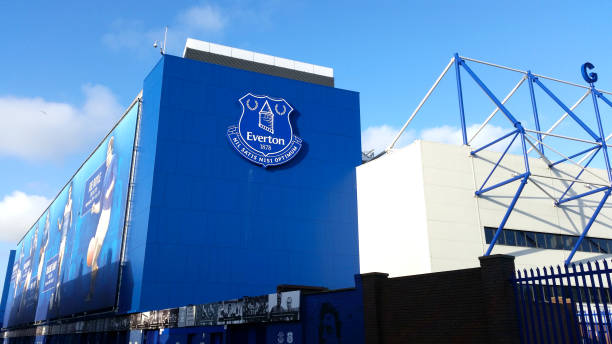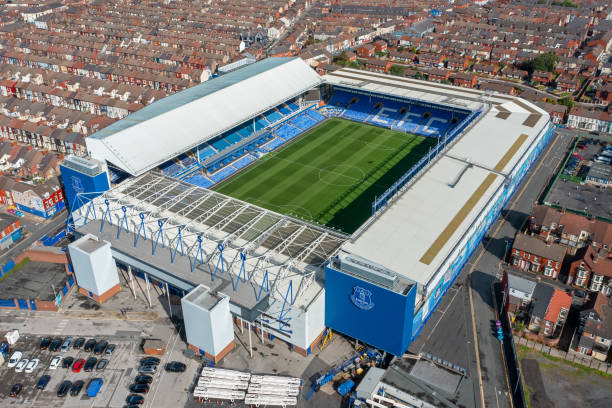A challenging location has driven out of the box thinking for the design and construction of Everton FC’s £500M riverside stadium. Everton Football Club hopes that its new £500M stadium by the River Mersey will be the catalyst for success. But regardless of what eventually unfolds on the pitch, there is no doubt that Everton’s Bramley-Moore Dock stadium will be one of the country’s most iconic sporting venues. It is being brought to life by innovative design and construction techniques in a challenging dockland location which adds to the engineering complexities. And modern methods of construction and digital design are at the heart of the solution. Laing O’Rourke is the main contractor for the £500M job, with North Yorkshire firm Severfield fabricating the steelwork. Consultant Buro Happold provided engineering design support to BDP Pattern in drawing up the stadium’s design. The stadium superstructure is being made from steel and precast concrete. In total 11,000 precast concrete components form the new stadium’s superstructure, floors, walls, supporting columns and terraces. A steel skeleton frame will support the superstructure as well as the roof. A brickwork skin will then be attached to the stadium’s façade. Construction started in summer 2021 and the club hopes to start playing matches at the 52,888-seater stadium by the end of 2024. The stadium site is on a former commercial dock with the River Mersey on one side, United Utilities’ Liverpool Wastewater Treatment Works to the north, a main road on the eastern edge and a disused dock to the south. It will stand in an infilled dock, which presented additional engineering challenges. An enormous infilling project had to be carried out before construction of the stadium’s superstructure could commence. Infilling the Grade II listed, 10m deep Bramley-Moore Dock with 480,000m3 of fluidised sand started in October 2021 and finished by the following March.

The Work Was Carried Out By Land Reclamation Specialist.
Royal Boskalis Westminster. It involved pumping sand dredged from Liverpool Bay and the Irish Sea into the dock via a pipeline connected to a dredging vessel moored in the River Mersey. A rapid dynamic compaction process was then carried out to consolidate the infill ahead of piling and eventually the construction of the stadium’s superstructure. The fill material was compacted by a 94t excavator with a purpose-built 16t vertical hammer arm. Despite the compaction process, Laing O’Rourke engineering lead Gerald Knights explains that it will be decades before the reclaimed land has fully settled because the sandy infill material will sit on soft silts at the bottom of the dock. A decision was made early in the project to retain the dock’s silts, which isn’t particularly normal for this type of project,” Knights says. “But we did it because it is really great for the environment although it does give rise to an engineering challenge. As the silts are compressible, settlement is inevitable.” He adds: “A lot of the initial settlement happens as soon as you put the sand in. Once there was 1m of sand in the bottom of the dock most of the settlement in the silt happened. Once we got up to dock ground level, the dock was settling somewhere around about 5mm a week. We are now down to less than that a month. “But essentially that [settlement] will continue for decades. It will slow down to fractions of millimetres a year but there are a few phases in the project’s lifetime when certain interventions will be needed to address that, for example the club may have to relay the pitch in the off season.” Historic England was against infilling the dock, as it believed it would fundamentally change its historic character. Its heritage concerns also means that the piling layout for the stands is designed to avoid the dock walls as these are listed assets. Theoretically it means the site could revert back to being a dock should the club decide to relocate sometime in the future. The stadium design and construction methodology have also been heavily influenced by the location. Knights explains that the stadium structure will be “fully suspended” to limit the effects of settlement. “[The dock location] led us to design the stadium as a fully suspended structure of piles and slabs suspended between the pile caps.”
Artist’s impression of the Completed Stadium Which Will Host its First Match in 2024
But there are elements of the scheme that are not supported by piles, including the pitch which will lie directly on top of the infill. Over time those will continue to settle and there will need to be a series of maintenance interventions during the lifetime of the project as a result. In total, 2,500, 600mm diameter bored cast insitu piles were needed for the stadium structure. The piles were formed to a depth of 18m through the dock infill and into the sandstone below. The piles are capped by floor slabs to give them extra stability. This creates a podium on which the superstructure is being constructed, leaving an empty space beneath the podium slab. It is within the void beneath the podium slab that the stadium’s utilities will be suspended. “All of the drainage for the stadium is fully suspended as well as all the ducting,” explains Knights. “Suspending the utilities is pretty unique. It’s [Everton Stadium is] not the only place that does it but it is rare.” The stadium’s drainage pipes are supported by a series of triangular steel “pipe hangers” which are attached to steel rods cast into the underside of the podium floor slab. Knights adds: “It’s much the same as what you might see in any building where you’ve got overhead utilities. Like if you’re in a car park you quite often see drains above your head and things like that. All we’re doing is replicating that in the void between the ground level and the floor slabs. It’s a fair challenge in getting that to work, in setting the rods within the slabs and in choosing the right timeframes to install it. So that’s quite technically innovative.”

Digital build
Laing O’Rourke has used a combination of advanced digital design and modern methods of construction – offsite construction – to build the stadium structure. Laing O’Rourke digital build lead Ellis McNulty explains that before a spade went into the ground, the entire stadium was broken down in the digital realm. This enabled engineers to work out every issue that could have arisen during construction. A 3D model of the stadium was created and broken into around 6,000 “modules” so that issues could be ironed out before work began on site. Laing O’Rourke’s subsidiary Explore Manufacturing worked on the design with consultant Buro Happold at its Centre of Excellence for Modern Construction in Nottingham. “Everything was broken down into modules, if you want to call it that, into components,” McNulty says. “On the model you can see the lattice planks, you can see the columns, you can see twin wall components, beams, etcetera. What that helps us to do in that 3D environment is pick up clashes between elements, check that they’ll fit correctly and check that the spacings between them are correct.“Rather than trying to have to fit two sets of 2D drawings together in your own head, you can do it in a full 3D immersive space.” A decision was made early in the project to retain the dock’s silts, which isn’t particularly normal for this type of project The 3D models used during design are then used on site by Laing O’Rourke foremen and construction managers. Breaking the stadium down into modules on the 3D model has also allowed Laing O’Rourke to timetable materials deliveries and capitalise on its use of modern methods of construction. Knights explains that the idea is to have, where possible, “a flat pack stadium” which is built offsite at the factory in Nottingham and then assembled on site. The precast concrete components for the terraces were the first to arrive on site, followed by steel components for the stadium’s skeleton and the brickwork skin façade. “We tend to try and almost flat pack the structures as best as we can. We call it the design for manufacturing and assembly methodology,” Knights explains. “And what this does is it takes a lot of work that would traditionally be done on site, offsite. So you get a better quality and you get better control of wastage. It’s more environmentally friendly and actually it’s quicker to build.” He adds: “There’s thousands of components on the job, all of which are being produced at the factory: beams, columns, lattice planks, etcetera. In total, roughly 6,000 components will eventually come out of the factory. We modelled each of those components in the digital environment first to ensure that they will work and to know what order they need to arrive on site.” Those components have already begun to make their way to site. Most of the precast elements are already in place and the five 100t roof trusses were lifted into position shortly before Christmas. Over 12,000t of steelwork will make up stadium’s structural frame which is on track to be completed in 2024.


Recent Comments